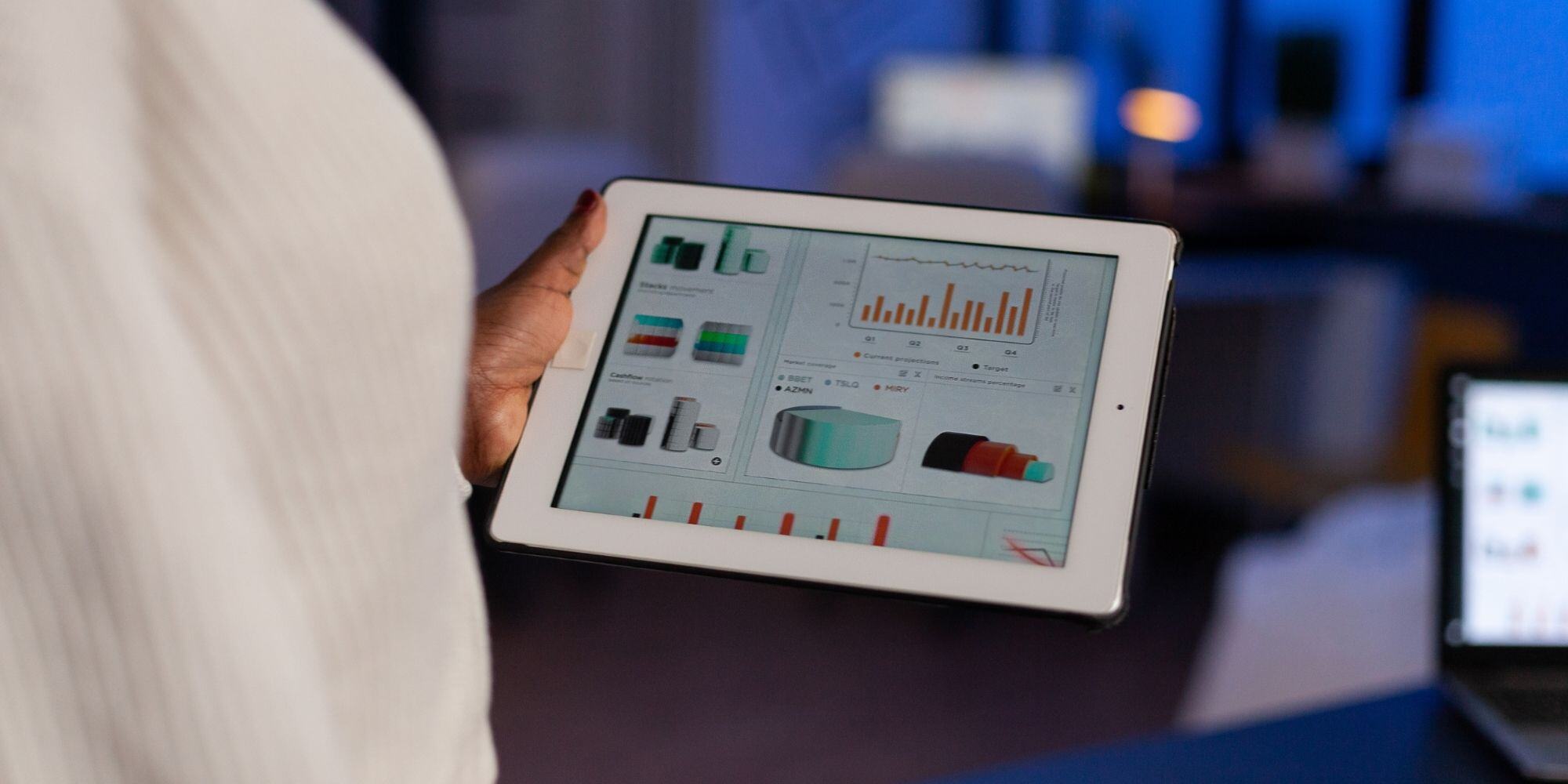
Manufacturing dashboards, often overshadowed by more prominent technological trends, are uniquely positioned to optimize production processes. They carve out their niche by offering unparalleled insights into operations, setting them apart in the vast landscape of manufacturing technologies. The distinction between traditional and digital dashboards marks a significant divide, each bringing distinct advantages.
What is a Manufacturing Dashboard?
A manufacturing dashboard is essential to visualize key performance indicators (KPIs) and metrics critical for monitoring and enhancing the production process. It is a centralized platform that grants managers and operators access to real-time data and insights. These insights are crucial for making informed decisions that drive efficiency and productivity.
By converting complex data into an easily understandable format, manufacturing dashboards streamline the task of tracking operational efficiency, productivity, and status. Whether leveraging the advanced capabilities of digital dashboards or the straightforward simplicity of traditional ones, these tools are customized to address the unique demands of a manufacturing setting.
This customization ensures that all stakeholders can quickly pinpoint areas needing attention and recognize achievements, making manufacturing dashboards indispensable for operational excellence.
What Distinguishes Digital from Traditional Dashboards?
The key difference between digital and traditional manufacturing dashboards is their data handling and presentation approach. Digital dashboards stand out for their capability to harness real-time data, providing a dynamic and interactive user experience that dramatically improves decision-making and operational efficiency. They leverage cutting-edge technology to deliver in-depth analytics, predictive insights, and instant notifications, fostering a proactive management approach, which can be exemplified by the use of digital displays in lobbies to convey real-time information.
Digital Dashboards Use Real-time Data
Digital dashboards are distinguished by their use of real-time data, revolutionizing how operations are monitored and managed. This feature ensures that data is continuously updated, providing an up-to-the-minute snapshot of manufacturing processes. It empowers stakeholders to act swiftly, promptly address issues as they arise, and capitalize on opportunities.
Traditional Dashboards Rely on Manual Data Collection
Conversely, traditional dashboards are grounded in manual data collection. This process entails gathering data at predetermined intervals, which can introduce delays in recognizing and responding to operational challenges. Although this method underscores simplicity and minimizes the need for advanced technological infrastructure, it inherently constrains the pace at which decisions can be made.
Why are Manufacturing Dashboards Important?
As the linchpin between data collection and actionable insights, manufacturing dashboards are pivotal in the contemporary production landscape. They empower management and operational teams to make informed decisions quickly. By offering a streamlined view of key performance indicators (KPIs) and other critical metrics in an accessible format, dashboards enable the easy identification of trends, inefficiencies, and areas ripe for improvement.
This enhanced visibility into real-time and historical data guarantees that resources are utilized effectively, maximizes productivity, and consistently meets quality benchmarks. Whether leveraging digital dashboards' advanced capabilities or traditional ones' straightforward simplicity, these tools are fundamental in fostering operational excellence, bolstering competitive advantage, and realizing strategic goals.
Advantages of Digital Manufacturing Dashboards
Digital manufacturing dashboards bring many benefits that significantly boost operational efficiency and the quality of decision-making. A key advantage is their ability to provide real-time monitoring and analytics, offering immediate insights into the manufacturing process. This feature enhances efficiency and productivity and equips managers with enhanced decision-making capabilities.
Real-time Monitoring and Analytics
Digital dashboards stand out for their real-time monitoring and analytics, offering a transformative approach to operational management. This feature provides instant visibility into every aspect of the manufacturing process, from production line efficiency to equipment status, ensuring that data is always current. Such immediate access to information enables quick detection and resolution of issues, optimizing operational performance and responsiveness.
Enhanced Decision-making Capabilities
Leveraging the rich, data-driven insights digital dashboards provide significantly enhances decision-making capabilities. With comprehensive analytics, managers can make well-informed, timely, and evidence-based decisions. This access to detailed, real-time data supports strategic planning and practical problem-solving, guiding operations toward success with greater precision.
Improved Efficiency and Productivity
Adopting digital dashboards leads to marked improvements in efficiency and productivity within manufacturing operations. By offering real-time insights into production workflows, these tools enable fine-tuning processes, anticipate maintenance needs to prevent downtime, and quickly identify production bottlenecks. This results in a more efficient use of resources, higher productivity levels, and reduced operational waste.
Scalability for Growing Operations
The scalability of digital manufacturing dashboards is critical, particularly for expanding operations. These systems are designed to grow with your business, easily integrate new data sources, accommodate more complex analytics, and support increasing users. This scalability ensures that digital dashboards continue to provide valuable insights and remain an integral part of operational strategy, regardless of the manufacturing operation's size or complexity.
Disadvantages of Digital Manufacturing Dashboards
While digital manufacturing dashboards offer numerous benefits, they have disadvantages. A significant hurdle for many manufacturers is the high implementation costs. Setting up these advanced systems often requires substantial investment in technology and infrastructure.
High Implementation Costs
One significant barrier to adopting digital manufacturing dashboards is the high implementation costs. These systems demand a considerable upfront investment in technology, including the hardware and software necessary to run them effectively. This financial hurdle can be daunting for small to medium-sized enterprises (SMEs), potentially diverting funds from other critical business needs.
Complexity and Need for Skilled Personnel
The complexity inherent in digital dashboards necessitates skilled personnel. Operating these sophisticated systems requires technical knowledge and expertise, making it essential for businesses to have access to trained staff. This requirement can lead to additional expenses and challenges, particularly for organizations needing more expertise.
Potential for Cybersecurity Risks
Cybersecurity risks pose a significant concern for digital manufacturing dashboards. The interconnected nature of these systems exposes them to the threat of cyber attacks, which can lead to the loss of sensitive data and disruption of operations. Mitigating these risks requires continuous effort and investment in security measures, adding another layer of complexity and cost to using digital dashboards.

Advantages of Traditional Manufacturing Dashboards
Traditional manufacturing dashboards bring a suite of benefits centered around their simplicity and ease of use. This approachability ensures that individuals across the organizational spectrum can engage with and understand critical production metrics without deep technical knowledge. The lower initial costs associated with these dashboards make them particularly appealing for smaller businesses or those operating with constrained IT budgets.
Simplicity and Ease of Use
The simplicity and ease of use of traditional manufacturing dashboards stand out as a significant advantage. These systems are designed for straightforward operation, allowing for quick comprehension and application of essential data. This accessibility ensures that team members, regardless of their digital literacy, can effectively engage with the dashboard, making critical information universally understandable and actionable.
Lower Initial Costs
Lower initial costs make traditional dashboards an attractive choice for many businesses. In contrast to digital alternatives that necessitate substantial investments in new technologies and training, traditional dashboards can often be implemented using existing tools and resources. This affordability facilitates a smoother, more cost-effective integration into manufacturing, offering immediate value without a hefty upfront expenditure.
Less Dependency on Technology
A notable benefit of traditional manufacturing dashboards is their less dependency on technology. By focusing on manual inputs and simpler systems, these dashboards reduce the potential for operational interruptions caused by technical issues or cyber threats. This lower technological reliance is especially beneficial for facilities in regions with unreliable internet connectivity or companies seeking to limit their exposure to digital vulnerabilities, providing a measure of resilience and security in their operations.
Disadvantages of Traditional Manufacturing Dashboards
While traditional manufacturing dashboards have merits, they have disadvantages. A significant limitation is delayed data reporting. Relying on manual data collection and analysis processes can lead to outdated information, which may slow down the ability to respond effectively to changes in production or market demands.
Delayed Data Reporting
One critical drawback of traditional manufacturing dashboards is their tendency towards delayed data reporting. The reliance on manual input and processing results in less timely information, directly impacting the ability to make swift adjustments in response to production dynamics or market changes. This lag can compromise operational agility and the opportunity to optimize processes in real time.
Limited Data Analysis Capabilities
Another limitation of traditional dashboards is their limited data analysis capabilities. Lacking the sophisticated tools and computational power characteristic of digital alternatives, these dashboards fail to deliver the comprehensive insights necessary for intricate decision-making. This shortfall can impede a deeper understanding of operational efficiencies, hindering strategic planning and innovation potential.
Challenges in Scaling Operations
The challenges in scaling operations present a significant hurdle for traditional manufacturing dashboards. As an enterprise grows, these systems' manual and essential nature need to work on accommodating the escalating scale and complexity of data management needs. This inability to efficiently process and analyze increasing volumes of information can lead to bottlenecks and inefficiencies, threatening the smooth expansion and adaptability of the business in a competitive environment.
Optimize Manufacturing with the Right Dashboard Solution
Choosing between digital and traditional manufacturing dashboards is a pivotal decision for any manufacturing operation, offering distinct advantages and challenges. Digital dashboards excel in environments prioritizing real-time data, advanced analytics, and scalability, providing a robust tool for enhancing efficiency and strategic decision-making.
To maximize the effectiveness of your production environment, understanding how to integrate these displays into the right settings is crucial. By selecting the dashboard that aligns best, manufacturing entities can significantly improve operational performance, boost productivity, and stay competitive in the ever-evolving industrial landscape. To explore the benefits of digital dashboards without the initial investment, consider a free trial of Rise Vision, a leading cloud-based digital signage solution, and discover how it can transform your approach to manufacturing efficiency and communication.





